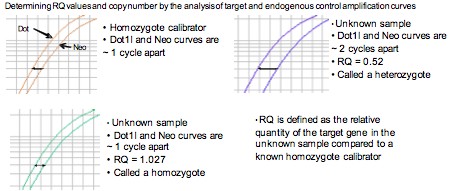|
Search:
|
|
| Article | |
What is quantitative PCR (qPCR) genotyping used by the MGP? |
(AUG65UAG) |
|
We use a qPCR reaction to count the neo gene marker present in the targeting cassette; heterozygotes will have one copy of the Neo gene, a homozygote will have two copies and a wild type will have no copies. Quantitative real time PCR (qPCR) copy number detection works by comparing the amplification curve of a target gene in an unknown sample to that of a known calibrator sample (typically a homozygote). In the qPCR reaction, a heterozygote will have half the amount of template available for the Neo marker compared to that of a homozygote. This translates to a one threshold cycle (Ct) difference in amplification rate during the exponential phase of PCR for heterozygotes compared to homozygotes. Wild type alleles will show no target amplification. To normalise for variability in the reactions (eg DNA concentration or the presence of inhibitors) and allow comparison between two different samples, the target gene (Neo) is first compared to an endogenous gene control reaction (in this case the Dot1l gene) for each sample. The relative quantity (RQ) and thus copy number of the unknown sample against that of the calibrator can then be calculated.
| |
| Also listed in | |
| Sanger MGP | |
| Attachments | |
